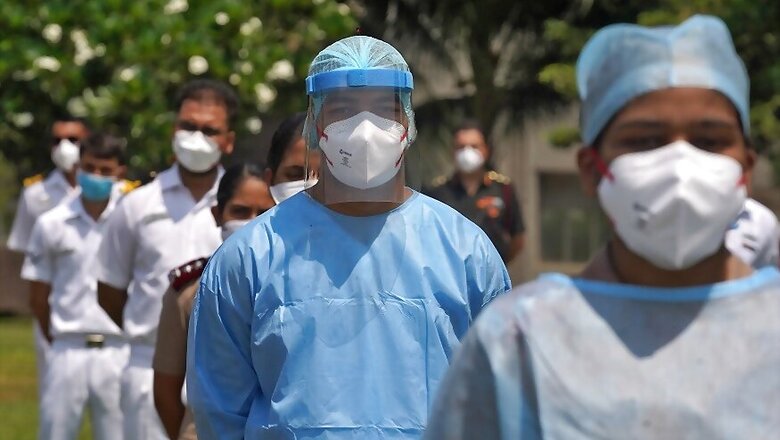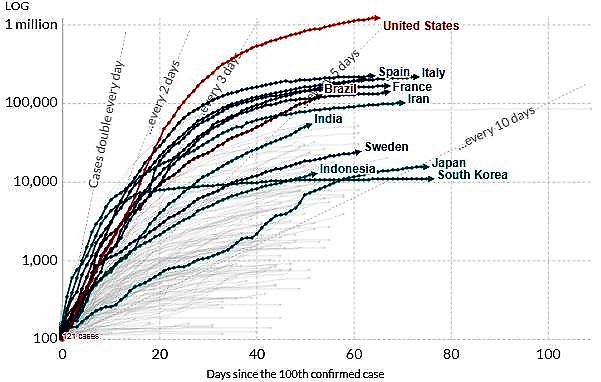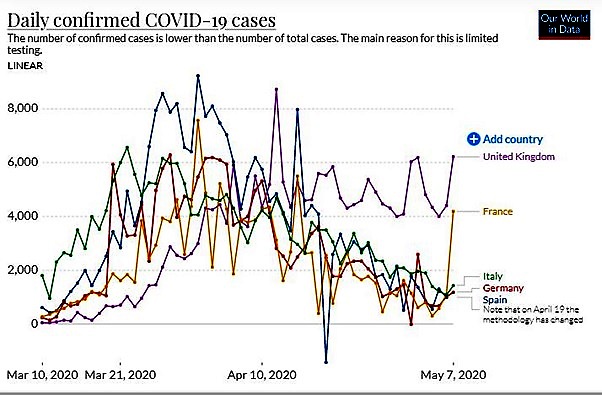
views
When will Covid-19 cases and deaths peak in India? That is a million-dollar question the answer to which a population of a billion plus is desperate to know. Earlier predictions had estimated the Covid-19 peak to hit India by mid-May but calculations have now revised the period to sometime between June-July courtesy the extended lockdown.
“Currently, the cases are continuing to grow at a flat rate, sometimes even more. So, it is very difficult to predict when the peak will come; but it is likely to peak around June or July. This is why we need to be prepared for it and more vigilant to bring the number of cases down,” said Dr Randeep Guleria, Director of AIIMS.
The ‘flat rate’ growth in cases Dr Guleria refers to is the big positive for India. While there has been a sudden rise over the last week, the rate of growth has been linear and shown a downward trend compared to the first half of April.
The range for the daily growth rate of cases has been between 4 per cent and 8 per cent for the last 15 days with the only exception being the last week when it touched 9 per cent on three different occasions. This range was between 5 per cent and 16 percent from the April 7 to 22, rising above 10 per cent on 9 of the 15 days in this period.
India initially did not witness a steep rise in cases as compared to some west European countries and the USA. If we count the 100th case in each country as Day 0, India has done comparatively well in comparison to USA, Spain, Italy, France, Iran, Brazil, Germany and UK amongst others.

However, the worry for India has been that despite the stringent lockdown, which has stopped the number of cases from exponentially rising into lakhs (which would subsequently have led to an increase in the number of deaths), the curve for ‘new cases’ has not flattened as it has in some other countries which had also enforced a lockdown.

The graph above shows the daily rise of cases in India from March 25 – the day the lockdown was enforced – till May 7. While the surge is not steep, there is no sustained period of flattening or downward movement, suggesting India is still far from its peak.
The problem for India is that with just nine days remaining for the lockdown to end and with already more relaxations in place coupled with increased testing, the number of cases will only increase more steeply.
In contrast to India, most west European countries saw an exponential rise in the number of cases (and deaths) but have managed to not only flatten the curve but also set it in downward motion during the lockdown.
Italy imposed a nationwide lockdown on March 10 while the hard-hit Lombardy region of northern Italy had already been shut two weeks prior. The country reached its peak on March 22 (6,557 new cases). After a few more days of up and down, the curve finally bent post March 27 and Italy reported 1,444 new cases on May 7.
Spain’s lockdown started March 14 and they reached their peak on April 1 with 9,222 cases. The curve dropped for a few days before again rising on April 15 to almost 8,000 cases. Since then, it has been on a downward spiral.
Germany’s lockdown was effective from March 22 and their 7-day moving average dropped from April 1. However, the real dip came April 10 onwards.
France imposed a nationwide lockdown on March 16 and started seeing a dip in their 7-day moving average from April 8, but the steep decline in new cases only started a week later, from April 15. However, the country saw a massive surge on May 6 and reported 4,183 new cases.
The daily cases graph of the United Kingdom has been quite flat since April 12 which was the peak for the country while even the United States has seen a sharp fall from April 26 from when they reported a whopping 48,529 cases.
Even Turkey, which has a total of 1,33,721 cases, has seen a drop in new infections from April 22.
Of course, just because a country has reached its peak and is now showing a downward trend does not mean that they have won the battle against Covid-19. Different countries, depending upon the severity of the virus to have hit them, have different peaks.
For example: USA, even though on a downward trend reported 24,128 new cases on May 7 which is multiple times higher than the peak of any other country.

According to Dr Andrea Ammon, the Director of the European Centre for Disease Prevention and Control (ECDC), most EU countries were seeing a substantial decrease and passed the Covid-19 peak.
The British Prime Minister echoed her views when he said, “We are past the peak, and we are on the downward slope.”
While cases are on the decline in Europe and America, some other parts of the world are seeing a surge in new infections. Brazil has seen a dramatic rise and reported more than 10,000 cases on May 7. Russia is also on the upswing and has reported more than 10,000 cases on each of the last 4 days.
The 7-day moving average in Peru has been increasing since April 6. Bangladesh, which had barely 50 cases till April 1, is now reporting more than 13,000 cases averaging more than 700 new cases for the past three days.
Where India has done better so far is in keeping its mortality rate low. At 3.35% it is drastically better than the likes of Belgium (16.38%), France (14.87%), UK (14.81%), Italy (13.87%), Spain (10.14%) amongst other major nations. It is even better than Germany’s (4.36%) which had done a remarkable job in controlling the number of deaths.
While all these countries are also past their peak in terms of new deaths, a high mortality rate still means they are reporting a high number of deaths. USA’s 7-day moving average on May 6 was 1,867, Italy (285), Spain (218), UK (549) and France (230).
India’s 7-day moving average (new deaths) on May 6 was 105 – a direct consequence of a slow growth in the number of cases coupled with a low mortality rate.
The lockdown in India may not have flattened the curve as in some other countries but its timing and severity ensured that India’s rate of growth was much slower than most of the European powers and US. It also helped to keep in check the number of deceased in India to a remarkably low figure even as Covid-19 deaths surged across the world. It also gave India breathing space and time to ramp up its medical facilities for when the infections rise after the lockdown is lifted.
If Covid-19 in India is to peak in June, the challenge for the country will now be to keep the rate of growth in infections and the mortality rate in check for the next few weeks. While it has relaxed the lockdown, it would need to strictly identify, monitor and control the spread in the containment areas of the Hotspots while keeping them cut off from the rest of the country till we hit our peak.
















Comments
0 comment